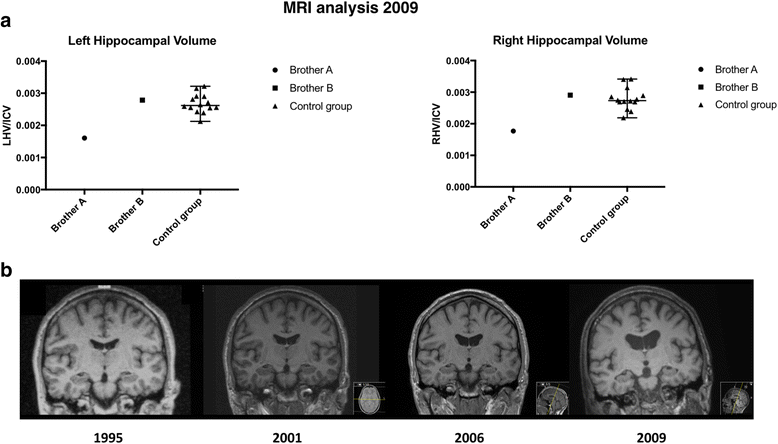Reduced penetrance of the PSEN1 H163Y autosomal dominant Alzheimer mutation: a 22-year follow-up study
- PMID: 29747683
- PMCID: PMC5944151
- DOI: 10.1186/s13195-018-0374-y
Reduced penetrance of the PSEN1 H163Y autosomal dominant Alzheimer mutation: a 22-year follow-up study
Abstract
Background: The range of onset ages within some PSEN1 families is wide, and a few cases of reduced penetrance of PSEN1 mutations have been reported. However, published data on reduced penetrance have been limited to clinical histories, often collected retrospectively and lacking biomarker information. We present a case of reduced penetrance of the PSEN1 H163Y mutation in a carrier prospectively followed for 22 years.
Methods: Two brothers (A and B), both carriers of the H163Y mutation, were followed between 1995 and 2017. They underwent repeated clinical evaluations, neuropsychological assessments, and cerebrospinal fluid analyses, as well as brain imaging examinations with structural magnetic resonance, [18F]fluorodeoxyglucose positron emission tomography, and [11C]Pittsburgh compound B positron emission tomography.
Results: Brother A was followed between 44 and 64 years of age. Cognitive symptoms due to Alzheimer's disease set in at the age of 54. Gradual worsening of symptoms resulted in admittance to a nursing home owing to dependence on others for all activities of daily living. He showed a curvilinear decline in cognitive function on neuropsychological tests, and changes on magnetic resonance imaging, positron emission tomography, and biomarkers in the cerebrospinal fluid supported a clinical diagnosis of Alzheimer's disease. Brother A died at the age of 64 and fulfilled the criteria for definitive Alzheimer's disease according to neuropathological examination results. Brother B was followed between the ages of 43 and 65 and showed no cognitive deterioration on repeated neuropsychological test occasions. In addition, no biomarker evidence of Alzheimer's disease pathology was detected, either on imaging examinations or in cerebrospinal fluid.
Conclusions: The average (SD) age of symptom onset for PSEN1 H163Y is 51 ± 7 years according to previous studies. However, we present a case of a biomarker-verified reduction in penetrance in a mutation carrier who was still symptom-free at the age of 65. This suggests that other genetic, epigenetic, and/or environmental factors modify the onset age.
Keywords: Autosomal dominant Alzheimer’s disease; CSF; Reduced penetrance; [11C]Pittsburgh compound B PET; [18F]fluorodeoxyglucose PET.
Conflict of interest statement
Ethics approval and consent to participate
All study procedures were approved by the regional ethical review board in Stockholm, Sweden, and informed written consent was obtained from the study participants, including for the presentation of case reports.
Consent for publication
Written informed consent was obtained from the study participants, including for the presentation of case reports.
Competing interests
The authors declare that they have no competing interests.
Publisher’s Note
Springer Nature remains neutral with regard to jurisdictional claims in published maps and institutional affiliations.
Figures


References
Publication types
MeSH terms
Substances
Grants and funding
LinkOut - more resources
Full Text Sources
Other Literature Sources
Medical

